|
“In as much as, in China, the Taoist Woo Dong Temple was made infamous by its Black Dragon Fighting Society destroying the Buddhist temples of the Shaolin. The title “Black Dragon Fighting Society” is also a designated term of honor bestowed upon all those linked by no-holds-barred mixed martial arts fights, initially, sponsored by Japanese Black Dragon Society (Kyūjitai; Shinjitai; kokuryūkai) which was a prominent paramilitary, ultra-nationalist right-wing group in Japan, at the turn of the 20th Century. The culmination of both western and eastern cultural fight promoters working together in the West, Russia, Korea, Manchuria, Japan, Vietnam, Thailand, and China, in 1900’s, gave rise to an unofficial union dubbed the “International Fighting Art Association, est. 1901. The Kumite is a secret society. Yet, it is so well known amongst Asian Martial masters anyone not familiar with its historical legacy is literally labeled “Offspring of Turtles.” Today, this is a KaJuKenBo tradition, where I personally watched the legendary Bloodsport fighter, my KaJukenBo brother Frank Dux, do it for real. So have a lot off people in the IFAA Official Black Dragon Fighting Society” – Grandmaster, Ron Pierce
|
|
|
|
|
|
|
|
|
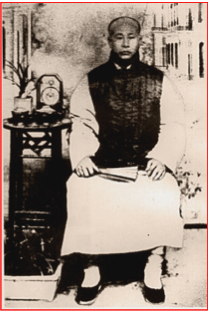 |
The 2006 Jet Li motion picture Fearless is based on the legendary true life experiences of a famous early 20th century Chinese martial artist Hou Yuanjia (left) who challenged foreign fighters in these highly publicized Bloodsport no-holds-barred mixed martial art events, in the late 1890’s, restoring pride and nationalism to China at a time when Western and Japanese imperialism were eroding the country. He is the ancestral teacher to Grandmaster Pierce and his lineage, etc.
|
|
|
|
|
|
|
|
The 1988 released film, Bloodsport, portrays the true life exploits of IFAA Official BDFS original member Frank Dux. It depicts how the
|
|
|
IFAA/Kokuryukai Black Dragons sponsor the events along with the existence of its past champion Senzo Tanaka, who is referenced in historical documents, paid Homage, in Fearless.
The Black Dragon Senzo Tanaka is renown throughout the inner circle of martial arts for putting an end to the Hou Yuanjia fighting dynasty whereby the event name is transformed from “San Soo” to “The Kumite.” Its prior historical origins can be traced back to Mongolian nomadic tribes of Genghis Khan then known as “Bandizo” and before that to the ancient Greeks, then known as Pancrantium. In theory, spread through the conquest of Asia by the Macedonian King, “Alexander The Great.”
The Black Dragon’s victories secured a language change that gave rise to the notion to become a “Black Dragon Fighting Society” member means gaining entrance into an exclusive fraternal order of “the best of the best” in martial arts. One fights for acceptance and competes without expectation of financial compensation.
|
|
|
|
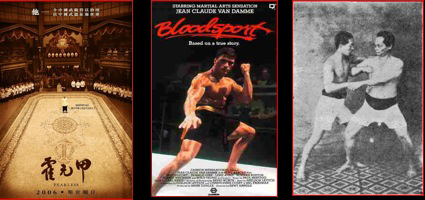 |
|
|
|
In 1943 Chicago, 140 lb Mas Tamura a “Black Dragon Fighting Society” Champion, chokes out 210 lb wrestler Karl Pojello in 1 minute and twenty second in a demonstration match for the US Military. This match was arranged by sportswriter for the Chicago Daily Times named Gene Kessler after the release of Behind the Rising Sun, "to find out about the comparative merits of our wrestling when matched against the Japs' jujitsu." It is amongst the first officially recorded Bloodsport Kumite/mixed martial art events, in the USA.
|
|
|
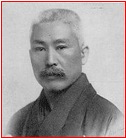 |
The Japanese Black Dragon Fighting Society Kokuryūkai was founded in 1901 by Uchida Ryohei (left) who was descended from the Genyōsha. Uchida was a student of Jigaro Kano (founder of Judo) and follower of the criminal organization Genyōsha (founded by Mitsuru Toyama.)
According to How Russia Shaped the Modern World: From Art to Anti-Semitism, Ballet to Bolshevism, Steven G. Marks, 2002; Uchida had been a student in St. Petersburg, knew Russian, and was in contact
|
|
|
with Russian revolutionaries in Nagasaki, whose violent politics he admired. Although his society's aim was to encourage Japanese domination of Manchuria and the entire Far East, in 1917 he called for an anti-Western alliance of Japan, Russia, and China, which he considered superior Asian civilizations. The assassination of moderate politicians was also a specialty of the organization whose leaders were disillusioned with the existing parliamentary order and opposed the government's domestic authority just as much as they urged its military expansion abroad
The Japanese Black Dragon Society name is derived from the Amur River, called Heilongjiang or "Black Dragon River" in Chinese (黑龍江?), read as Kokuryū-kō in Japanese. Its stated public goal was to support efforts to drive the Russian Empire out of East Asia, south of the Amur River.
The Kokuryūkai initially appeared to distance itself from the criminal elements of its predecessor, the Genyōsha, given its membership included Cabinet Ministers and high-ranking military officers as well as professional secret agents. However, as time passed, it still made use of criminals and their activities to be a convenient 'means to an end' for many of its operations.
The Society published a journal and operated an espionage training school, from which it dispatched agents to gather intelligence on Russian activities in Russia, Manchuria, Korea and China. It also pressured Japanese politicians to adopt a strong foreign policy. The Kokuryukai also supported Pan-Asianism, and lent financial support to revolutionaries such as Sun Yat-sen, and Emilio Aguinaldo.
During the Russo-Japanese War, annexation of Korea and Siberian Intervention, the Imperial Japanese Army made use of the Kokuryūkai network for espionage, sabotage and assassination. They organized Manchurian guerrillas against the Russians from the Chinese warlords and bandit chieftains in the region, the most important being Marshal
|
|
|
Chang Tso-lin. The Black Dragons waged a very successful psychological warfare campaign in conjunction with the Japanese military, spreading disinformation and propaganda throughout the region. They also acted as interpreters for the Japanese army.
The Kokuryūkai assisted the Japanese spy, Colonel Motojiro Akashi. Akashi, who was not directly a member of the Black Dragons, ran successful operations in China, Manchuria, Siberia and established contacts throughout the Muslim world. These contacts in
|
|
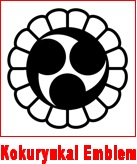 |
|
Central Asia were maintained through World War II. The Black Dragons also formed close contact and even alliances with Buddhist sects throughout Asia.
During the 1920s and 1930s, the Kokuryūkai evolved into more of a mainstream political organization, and publicly attacked liberal and leftist thought. Although it never had more than several dozen members at any one time during this period, the close ties of its membership to leading members of the government, military and powerful business leaders gave it a power and influence far greater than most other ultranationalist groups.
Initially directed only against Russia, in the 1930s, the Kokuryūkai expanded its activities around the world, and stationed agents in such diverse places as Ethiopia, Turkey, Morocco, throughout southeast Asia and South America, as well as Europe and the United States.
The Kokuryukai, Japanese Black Dragon Society murdered its way across the globe and established its 1st presence in Chicago and Los Angeles in the 1930’s. They viewed racial inequality and strife as a vulnerability they could exploit to benefit their intelligence and criminal organization loyal to imperial Japan. Thus, the Japanese Black Dragon Society began aligning themselves with the mafia and financially backed Muslim organizations as well as civil rights movement as the Black Dragon’s viewed their role as being the voice of lesser peoples “non-whites.” Secretly teaching Judo/Jujitsu to minorities after hours by explaining to a white society their students when seen entering and leaving buildings after working hours were there as janitors.
|
|
|
|
 |
Like they did in Russia and Manchuria the Black Dragon Society sponsored Kumite mixed style matches and formed Judo clubs on military installations. This activity continued until the Kokuryukai plans were discovered and several members, jailed. On 27 March 1942, FBI agents arrested members of the Black Dragon Society in the San Joaquin Valley of California.[2]
|
|
|
"Waiting for Tojo: The Pro-Japan Vigil of Black Missourians, 1932-1943).
|
|
John Keehan (right) allegedly resigned from the USKA organization in 1964 with the USKA patronizing “whites only” facilities in conducting its tournaments as well as refusal to promote minorities other than Asians to rank of Black Belt. He told Black Belt Magazine that in 1964 “the USKA didn’t have any Negroes in the organization, except for mine, and Trias didn’t like it one bit. . . . It’s the truth. Of course, now he has no qualms about it, but at the time, that’s the way it was.”
Trias, in a 1975 article, dismissed this as “nonsense.”
|
|
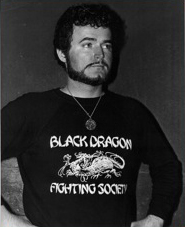 |
|
|
|
|
Keehan formed with Douglas Dwyer The World Karate Federation but this lasted only a short period. Allegedly, wanting to challenge traditional boundaries Keehan parted ways with Doug Dwyer to establish the Black Dragon Fighting Society; its running dragon symbol is copied from a Chinese restaurant menu displaying the Chinese Zodiac.
In 1990, a new and unrelated World Karate Federation was formed.
In Chicago, allegedly under the auspices of former Black Dragon Society members, like Takahashi, John Keehan, who had participated in Kokuryukai style full contact Kumite returned from Asia to promote the first open to the public full-contact Kumite Bloodsport style mixed martial arts tournament held at the University of Chicago, on July 28, 1963. Many other such tournaments were hosted by him during the 1960s, pairing practitioners of different styles against one another in these bare-knuckle full contact events.
Keehan’s early tournaments attracted a host of martial-arts luminaries—like Ed Parker, Jhoon Rhee, and a pre-Enter the Dragon Bruce Lee—as well as new students. James Jones, a 66-year-old retiree now living in Hazel Crest, signed on at Keehan’s Rush Street school the day after he attended the U. of C. event. He studied with Keehan for three years and remembers him as an ideal instructor. “John was a person who focused on basics and fundamentals,” he says. “He had excellent form and techniques.” He also says that Keehan was one of the few men who could side kick or punch a brick in half, though at one event it took three strikes and Keehan wound up breaking five bones in his hand. Still, he showed up at the dojo the next day, his hand in a cast.
But Keehan also had an arrogant streak. “John was the type of person who enjoyed attention and being in the limelight,” Jones says. “‘If you’re talking about me, then you know about me.’ I thought that was a weakness: ‘What can I do for myself instead of the art?’” Arthur D. Rapkin, a Milwaukee-area acupuncturist who studied under Keehan from 1965 to 1971, recalls Keehan’s “chronic” arguing with other karate schools. His ideas for tournaments were the biggest problem. Unlike most other teachers, Keehan advocated Bloodsport Kumite mixed martial art full-contact matches—no safety equipment, no pulled punches.
Jones, who trained under both men, believes that there probably was a de facto ban on minorities in the early days of the USKA but that the battle between Trias and Keehan likely had as much to do with control as with race.
Trias later said that Keehan “was given too much power too young and too fast,” and in his mid-20s the future Count Dante did seem to start drifting off course. On July 22, 1965, Keehan and Doug Dwyer, a longtime friend and fellow instructor, were arrested after a drunken attempt to blow out a window at Gene Wyka’s school with a dynamite cap. After they were apprehended, Dwyer was charged with four traffic violations; Keehan was charged with attempted arson, possession of explosives, and resisting arrest. He got two years’ probation.
Around the same time Keehan bought a lion cub—a legal, if uncommon, practice before the 1969 Illinois Dangerous Animals Act—which he kept at his dojo on Ashland and walked around town like a dog. (He later sold it to the Lions Club of Quincy, Illinois.) In the summer of 1967 he promoted an audacious exhibition in which, as part of a tournament at Medinah Temple, a bull would be killed with a single blow. Keehan purchased a bull from the stockyards and drove it around town on the back of a flatbed truck festooned with signs announcing the event. He wouldn’t perform the deed himself: he’d picked Arthur Rapkin, then a 19-year-old student, for the task.
Bull killing was the signature stunt of karate legend Mas Oyama, and Rapkin initially seemed game: in a Tribune article about the event (headlined “Karate Expert Thwarted as Bull Hitter”), he’s quoted as saying that if the police prevented him from attacking the bull in the building, he would “kill it in the truck on State Street, if necessary.” But after the seats were filled Keehan announced that the event had been shut down by the Chicago SPCA. In hindsight, Rapkin says, he believes Keehan and his associates never seriously considered staging the event. “They were probably just howling at this little Jewish kid from Milwaukee they were going to put up against this bull,” he says.
In San Francisco, Bob Calhoun leads a band called Count Dante & the Black Dragon Fighting Society. Originally knowing little about Keehan outside of the comic-book ads, he invented an outsize stage persona that’s part punk, part karate-ka, part motivational speaker, and wears leopard-print kimonos onstage. “What was funny was how much my portrayal turned out to be like the real Keehan in the first place,” he says.
|
|
|
Like a WWF wrestler living a role by which to build fan base, John Keehan changed his name to Count Dante. Explaining this occurred as a result of his parents fled Spain during the Spanish Civil War. They changed their names and obscured their noble heritage in order to effectively hide in America. All the while, Keehan knowing the surname Dante is in fact of Italian origin. Keehan having taken the name (Count) Dantès from the protagonist of Dumas' 1844 The Count of Monte Cristo, as Keehan saw his role as avenging the wrongs being committed against him and minorities at the height of the civil rights movement. Faced by martial mystics he declared himself a voodoo priest, by which to promote himself.
|
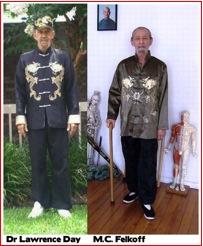 |
|
|
|
According to original BDFS founding members Grandmaster, Lawrence Day and Michael Felkoff:
“In 1969 when John Keehan broke away from Dwyer and officially formed the Black Dragon Fighting Society, he chose as his symbol a running dragon looking back on itself to honor his “Bloodsport” Kumite fighting roots and his Black Dragon instructors, (e.g. Ka-Ju-Ken-Bo Master, Dr. Robert Rapue and Senzo Tanaka). Tanaka was going by a different name when not in the company of Japanese businessman and Japanese Black Dragon Society member, Major Takahashi, who had a black wife. Keehan’s relationship with them and his black students inspired him to not give the martial arts world of that day any respect for the way it divided people because of their skin color, like preventing Victor Moore from competing for a title. When the opportunity presented itself Moore, an original (BDFS) bested the likes of Bruce Lee, Joe Lewis, Bill Wallace, Chuck Norris, Mike Stone and alike. If not for original Black Dragons taking over a ‘whites only’ hotel and outnumbered 20 to 1 and risking going to jail, Vic never would have his chance to fight and become the first Black World Karate Champion. In the same spirit as capture the flag the BDFS promoted the Chinese Triad Green Dragon Schools dragon symbol as our own, that resulted in a dojo war and the death of my Sensei, Jim Kosevic.” –Dr. Day
|
|
|
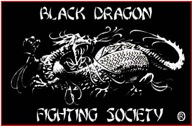 |
|
|
|
 |
|
|
Keehan is said to have mocked the traditional martial arts lock out of minorities by promoting his alter ego Count Dante via comic book ads as the Deadliest Man Alive. One had only to mail order for his instructional booklet World's Deadliest Fighting Secrets (in which he outlined the "Dance of Death") and they also received a free Black Dragon
|
|
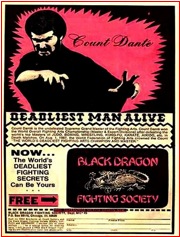 |
Fighting Society membership card because all are welcome to study and feel they had a right to belong. These comic book ads account for much of Count Dante's lasting notoriety in pop culture. They read:
Yes, this is the DEADLIEST and most TERRIFYING fighting art known to man—and WITHOUT EQUAL. Its MAIMING, MUTILATING, DISFIGURING, PARALYZING and CRIPPLING techniques are known by only a few people in the world. An expert at DIM MAK could easily kill many Judo, Karate, Kung Fu, Aikido, and Gung Fu experts at one time with only finger-tip pressure using his murderous POISON HAND WEAPONS. Instructing you step by step thru each move in this manual is none other than COUNT DANTE—“THE DEADLIEST MAN WHO EVER LIVED” (THE CROWN PRINCE OF DEATH).
|
|
|
In May 1975, at age 34 Keehan passed away, unexpectedly. According to urban legend the death touch Tibetan Iron Palm strike was allegedly administered to John Keehan. Killed over his flamboyant transgressions and associations regarding Black Dragon ties to the Chicago and Japanese, mafia. Nonetheless, as legend goes with his death the invitation to fight went to another protégé of Senzo Tanaka, Frank Dux, the basis of the 1988 classic film based on true events in the life of (BDFS original member) Frank Dux - Bloodsport.
A common myth promoted on glorified and unreliable message boards like Wikipedia and internet is the Black Dragon Fighting Society as once founded by John Keehan AKA Count Dante is currently under the sole directorship of a personally chosen protégé and successor to Keehan, William V. Aguiar of Fall River, Mass. Aguiar died in January, 2005. The fact is according to several Chicago BDFS original members, due to the obstacle of distance between them William V. Aguiar received minimal training by Keehan and longtime BDFS members. However, he was granted use of the BDFS name and provided a key to Keehan’s office able to access all his materials in order to assist in booking BDFS seminars and tournaments in the 1970’s.
However, the title “Supreme Grandmaster” as is claimed by his son Bill Aguiar III is apparently, invented after Keehan’s death, say GM Felkoff and Day. Notwithstanding, the name Black Dragon Society was trademarked by Bill Aguiar III in the USA, in 2008, as it pertains to operating schools and providing other instructional services. Bill Aguiar III was not born when the initial Chicago/Keehan BDFS was created. No evidence exists that demonstrates he has ever been ranked or recognized as a certified teacher of The Black Dragon Fighting Society (even by his own father, now deceased) says BDFS original members, Grandmasters, Lawrence Day, Ashida Kim, Ernie Reynolds, Michael Felkoff, Doug Dwyer, etc. which has erupted into an online rift that knows no shame. Given spurious threats of protracted litigation and internet libel made on a blog administered by Aguiar III and his followers - who attempted to derail a documentary on John Keehan AKA Count Dante and the revelation of the true history of Keehan’s Black Dragon Fighting Society by film-maker Floyd Webb (below).
|
|
|
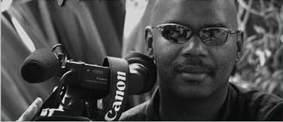 |
|
|
|
The International Fighting Arts Association Official Black Dragon Fighting Society is not a historical society of Keenan’s BDFS, it is not a martial style or secret society as in the past but is an international fraternal organization, as established out of South Africa. The IFAA is still host to the legendary Kumite as depicted in the 1988 film, Bloodsport. IFAA Official Black Dragon Fighting Society members may compete or attend without written invitation
|
|
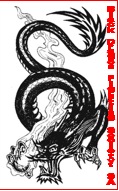 |
In 1962, South Africa, under the guidance of Black Dragon trained Ben Mangels, the Black Dragon Fighting Society INTERNATIONAL is the outcome of an anti-apartheid human rights movement. The South African Black Dragon Fighting Society is historically linked to Kokoryukai kempai Tai/Koga Ninjutsu. It merged with the IFAA, est. in 1901, to preserve the traditional bare knuckle Kumite style event just as depicted in 1988 film, Bloodsport. South Africa currently serves as the domain of the world headquarters for the privately held International Fighting Arts Association. It is administered by IFAA Official BDFS original member Professor,
|
|
|
Stoffel Van Vuuren, who hosts the invitation only IFAA/Kokoryukai sanctioned Bloodsport.
Black Belt magazine, November 1980, editor John Stewart, Kumite: A Learning Experience, points out “while not a publicity seeking organization the IFAA is far from being a secret organization,” as is romanticized by the martial art cult classic film, Bloodsport.
The 1980 Black Belt Magazine featured IFAA Official BDFS member, 1975 to 1980 World no-holds-barred Champion, Frank Dux, in their September, October and November issues of the magazine. In the November issue, John Stewart editor of Black Belt magazine wrote in the article "Kumite: A learning experience".
|
|
|
|
"From time to time, BLACK BELT learns of unusual events or occurrences in the martial arts; events that-either because of their nature or because they occurred in the distant past- cannot be easily verified. Because we don't want our readers to be misinformed, BLACK BELT has a policy of strict verification of all facts pertaining to any article. In the case several members of the staff have invested considerable amounts of time and energy checking the details of the following article, which was the product of a series of four interviews conducted over a period of three months. Although there is no convenient way to verify each and every detail connected with this story, the editors have verified enough of the basic facts to feel confident in publishing it." - John Stewart Black belt magazine nov. 1980
|
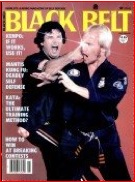 |
|
|
|
http://books.google.com/books?id=JtIDAAAAMBAJ&pg=PA34&dq=frank+dux&as_pt=MAGAZINES
|
|
|
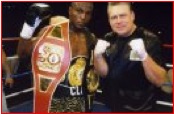 |
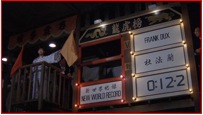 |
|
|
|
|
|
|
It is the measurable achievements of The IFAA Official Black Dragon Fighting Society Members (i.e. Frank Dux, Vic Moore, Jeff Langton, Stoffel Van Vuuren, Ron Pierce, Ashida Kim, Ernie Reynolds, Ji Han Jae, Irving Sotos, Lawrence Day, et al that facilitates it’s reputation as the fraternal order composed of the “best of the best” in martial arts, today.
|
|
|
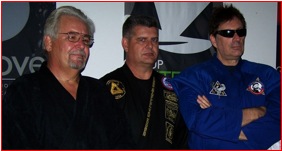 |
|
|
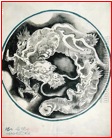 |
BLACK DRAGON KUNG FU
Claims of sole proprietary right as to determine who is a “Black Dragon” in terms of martial arts and trademark is ludicrous when one takes into account, according to Chinese folklore, in the year 520 A.D. a Buddhist monk named Bodhiharma (Da Mo to the Chinese) entered China bringing a new form of Buddhism called Ch’an (Zen in Japanese). He ended up at a Buddhist
|
|
|
temple located at the foot of the Sung Shan mountains next to a small forest. It was called the Shaolin Temple for shaolin means small forest in Chinese. It was his intent to spread the Ch’an sect of Buddhism. This new sect was a more direct form Buddhism which involved long periods of static meditation. Finding the monks of Shaolin to be in less than top physical form, Da Mo, who was believed to be trained in both Yoga and the fighting arts of India and Persia, developed a set of eighteen exercises based on breath work and isometric stretches called Ji Jin Ching, or Muscle Change Classics. He taught these to the monks of the temple and they became a part of their daily life. There is no doubt that forms of boxing already existed in China. But from the Shaolin Temple with its mandatory practice came a reputation of monks who were highly skilled in martial arts. Various styles of fighting developed, some based on the defense maneuvers or characteristics of animals.
As time passed, Kung-fu styles spread throughout China. In the year 714 A.D. legend has it that the Black Dragon style of Kung-fu was developed at the temple in Kwangtung, China by a man named Wu Chen Pai. He is referred to as Si Jo which means founder. He named his style Sillum Wu Hok Lung. Sillum is Cantonese for Shaolin, Wu is his family name, and Hok Lung is Cantonesd for black dragon. In Mandarin it is Shaolin Wu Hei Long. At the temple in Fukien province a style had developed known as Five Animal Style. Black Dragon was a "cousin" style to this also using the animal styles of dragon, tiger, crane, snake, and leopard. Later, Black Dragon added eagle, monkey, and praying mantis as well as a drunken form, today.
|
|
|
Eight Virtues of the Shaolin Warrior
Compassion
Courage
Honor
Patience
Respect
Self Discipline
Strength
Wisdom
|
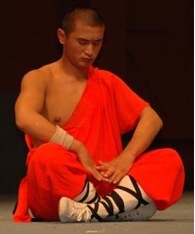 |
|
|
ABOUT THE BLACK DRAGON WU Family STYLE
The Black Dragon style is mostly known for its trapping and infighting preference. Although kicks are used, it is primarily a close range style. It also contains drills such as rolling hands, sticking hands, and push hands designed to increase sensitivity to an opponent's movement thereby improving fighting skill.
The dragon is symbolic of the warrior's inner spirit, and since inner growth is one of martial art goals, it became representative of some styles. The eight animals allow any body type or mindset to find a fighting style that suits them while learning from and growing through study of the others.
The following is a list of all Wu Family Black Dragon lineage holders, the time period of their position as Grand Masters and their geographic locations.
- Lineage(founder) Wu Chen Pai 714-762 Honan
- Wu Mai (female) 762-780
- Wu Ho 780-792
- Wu Peng 792-827
- Wu Chen-Wu 827-859
- lineage break
- Wu Hng-Tan 872-898
- Wu Tai 898-920
- Wu Cho-Pu 921-968
- Wu Hng 968-991
- Wu Ti (female) 991-994
- Wu Li 994-1023
- Ho Li 1024-1076
- Wu Pak Fu 1078-?
- lineage break
- Wu Bin Lun 1120-1142
- Wu Su-Lo 1142-1160 Fukien
- Wu Jan-Fat 1160-1181
- Wu Bin-Lo 1181-1212
- Wu Tu-Rui 1212-1214
- (shared lineage) Wu Han-Ti 1214-1242
- Wu Han-Li 1214-1251
- Wu Ji 1251-1276
- Wu He 1277-1301
- Wu Chen-Mi 1301-1330 Fukien
- (shared lineage) WuFat 1330-1352 Fukien
- Wu Han-Po 1335-1361 Kwangtung
- (shared lineage) Huang Chen 1352-1380 Fukien
- Wu Mao-Su 1361-1394 Kwangtung
- Wu Chen-Li 1380-1412 Fukien
- Wu Fat 1412-1442
- missing period
- Wu Ping 1523-1576 Kwangtung
- Wu Bin-Bai 1576-1578
- Huang Jing-Lun 1578-1601
- Bei Shang-Huan 1602-1643
- Wu Bai 1643-1684
- Wu Yi-Kuang 1685-1693 Vietnam
- Wu Man-Kou 1693-1742 Vietnam
- break or missing
- Wu Too-Rong 1791-1801 Kwangtung
- Wu Chen-Mai 1801-1842
- Wu Chen-Lee 1843-1891
- Wu Cheng-Fu 1891-1923
- Wu Han-Su 1923-1987 USA
- Ike Bear 1987- present USA
(Re: http://www.blackdragonsociety.org/BlackDragonHistory.html)
The International Fighting Arts Association Official Black Dragon Fighting Society is not a style/ryu or secret sect as may be the case in the past given its intersecting legacies but has grown into an international fraternal order, as established and officially sanctioned by the government of South Africa.
The IFAA is still host to the legendary Kumite, legally sanctioned in South Africa, as depicted in the 1988 film, Bloodsport. IFAA Official Black Dragon Fighting Society members may compete or attend without written invitation. Frank Dux and IFAA Official BDFS originals assist in organizing and promoting the invitation only, events. Contact Professor Stoffel Van Vuuren, for details.
|
|
|
|
|
|
|
|
|
|
|
|
|
|
|
|
|
|
|
|
|
|
|
|
|
|
|
|
|
|
|
|
|
|
SYMBOLIIC MEANING OF THE IFAA OFFICIAL BLACK DRAGON FIGHTING SOCIETY DRAGON:
The symbolism of the dragon, its name and origins are multi-cultural as well as thousands of years old. In the western culture the dragon symbolizes evil and has to be fought while contrarily the eastern culture’s dragon has its roots in the Chinese mythology; was said to live in the skies and had the ability to bring rain to an agricultural society. Notwithstanding, in terms of Asian martial arts the meaning of a Dragon is, generally, defined and used by the IFAA Official BDFS as follows:
|
|
|
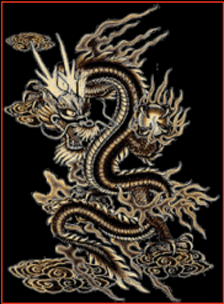 |
Internal Body of the Dragon: A Family Within
The Vital and Major Force in Life.
The Sea, the Breath of Life, the Tradition, and the Family.
Dragon's Lower Legs - Parents
The Head of and the Strength of the Family.
The Mother and the Father Hold and Mold the Family Together.
To walk around the world to share with the Family the Creation of Mankind.
The roots of the Family.
Dragon's Upper Legs - Children
The child that is part of the children that will reach out to others.
The youngest, the young and the new.
The one that will standout.
The one who is mischievous and a rascal.
|
|
|
The Dragon's Bones & Claws
Tools to Work with and Weapons for Self Defense.
The Dragon's Spine – Ancestral Legacy
The Elders, the Genesis, the Beginning, the Strength, the Bone that stands tall and strong as the backbone of the Family’s Wisdom.
The Dragon's Scales and Strong Skin
The People around the world regardless of race or color.
The Many Martial Systems around the world,
And the Many Traditions and Styles.
The Dragon's Tail
Security.
The instinct to Protect and Secure the Home Area.
|
|
|
 |
The Dragon’s Globe It Grasps
Unity of Mankind, Balanced Living and Integral Moral Conduct,
(Study war to ensure peace)
|
|
|
The International Fighting Arts Association Official Black Dragon Fighting Society is a “FRATERNAL ORDER” representative of the blending of martial art culture and legacy.
The IFAA membership represents a circle of influence composed of intersecting yet diverse martial art cultures, lineages and legacies. The oak leaf cluster as once worn by ancient leaders of the ancient world and champions, represents honoring leadership and the legacy of competing in no-holds-barred martial art competition that can be traced all the way back to the first Olympics.
The centerpiece dragon symbolizes not just one being acknowledged as being amongst the “best of the best” tested by battle or in Kumite (as one must be invited to join) but also represents the unified and international commitment to oppose and fight evil, the symbolic black dragon which symbolizes a lack of humility, elitism and indifference to the weak & poor; from which the fraternal order gets its name Official Black Dragon Fighting Society – members proclaim to fight the black dragon inclinations in oneself and others.
|
|
|
 |
|
|
What is expected of a member of the Official Black Dragon Fighting Society is one officially is committed to battle the evil “black dragon” within one as well as without, through camaraderie “one for all and all for one.” Membership in this fraternal order means everyone is publicly declaring they are part of a family in which martial art rank and traditions are respected and protocol shown, but is not the end goal.
|
|
|
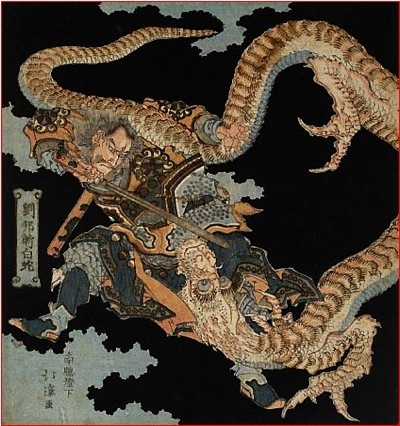 |
|
|
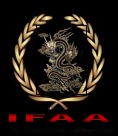 |
|
|
|
|
|
|
|
|
|
|
|
|